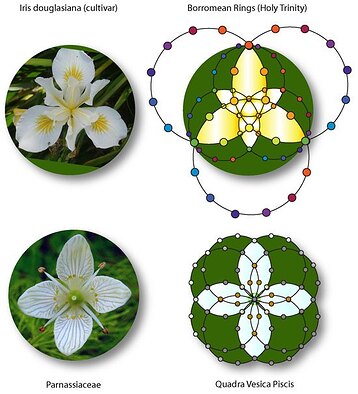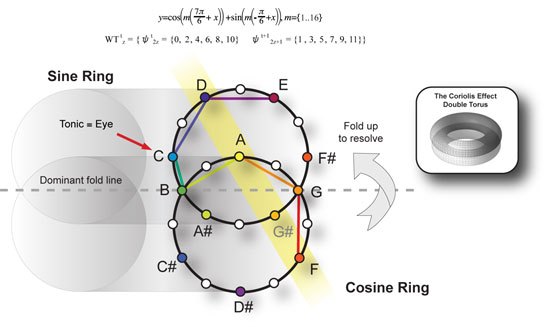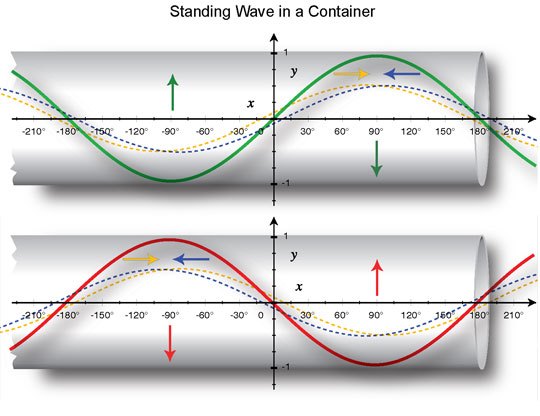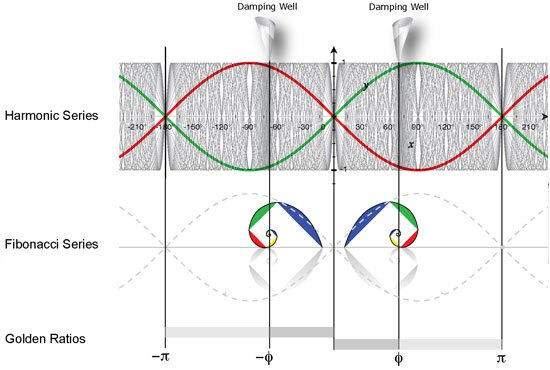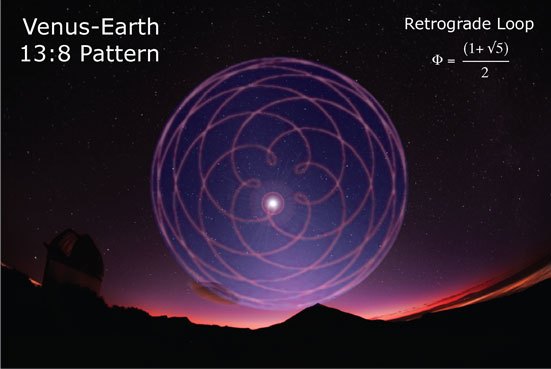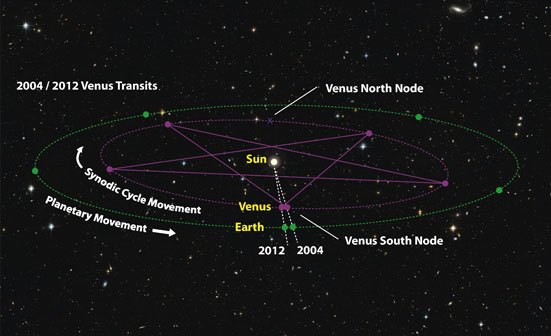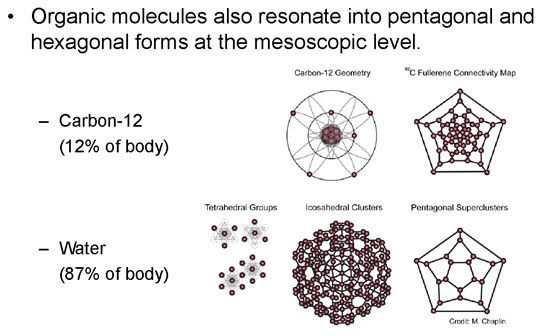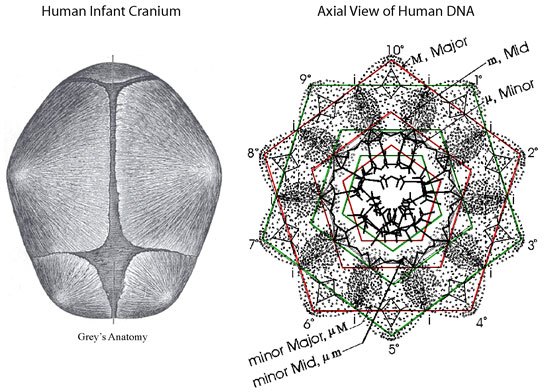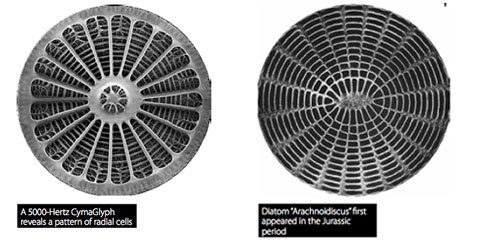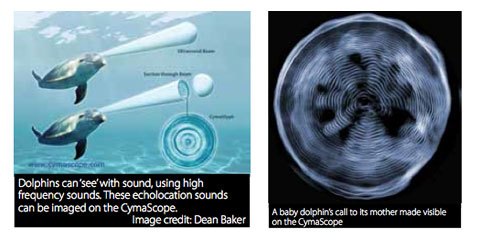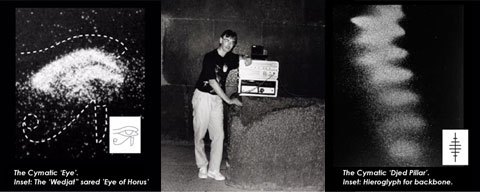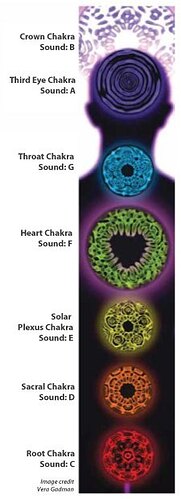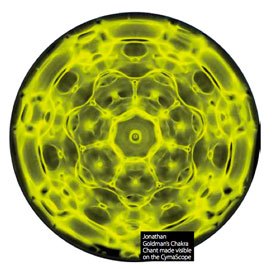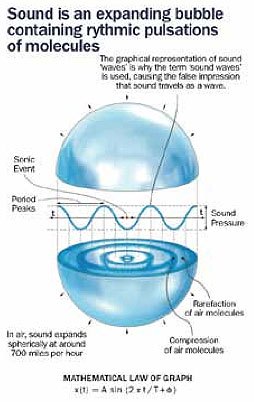Cymatics Today, a Window into the Universe
The underlying principle of cymatics is that the geometry of sound can be imprinted onto membranes and made visible with special techniques. The membrane can be a flexible material, such as latex or your skin, while other surfaces, such as brass or glass plates, may appear rigid yet they can still be minutely imprinted by sound. Simply by sprinkling on a little powder or sand, provided the membrane is horizontal, the imprint of sound can be revealed. The particulate matter gathers in the areas that are not vibrating, leaving the vibrating areas clear of particulate. Cymatic patterns are, therefore, rather like a photographic negative, because they represent the inverse of the sound that caused them to form.
Below is a typical CymaGlyph created with sand on the CymaScope that reveals a fundamental frequency of 5000 Hertz. Note the similarity between this cymatic pattern with the structure of a diatom, a sea creature that first appeared in the oceans of the Jurassic period, around 185 million years ago.
We used sand in our early research as the disclosing medium, but we soon discovered that water, with its highly flexible surface tension, acts like a super-thin membrane and reacts almost instantly to any sound, revealing very high levels of detail.
In the water CymaGlyph below an ultra- pure tone of 22.2 Hertz demonstrates archetypal pentagonal geometry creating an almost 3D view of sound. This CymaGlyph compares remarkably with the structure of the Campanula flower.
Dolphin Research
Applications for the CymaScope are beginning to emerge in many different fields. For example, in collaboration with Jack Kassewitz of SpeakDolphin.com we have taken the first steps in unraveling the mystery of dolphin language. We are contributing to their research program by transcribing dolphin echolocation sounds into CymaGlyphs, with each image representing a type of dolphin picture word. The image below is that of a CymaGlyph created by a baby dolphin calling to its mother. The call creates a replicable pattern of acoustic energy with a particular meaning. The second graphic illustrates the basic principle: a cross section through the dolphin’s high frequency sound beam is made visible on the CymaScope.
Signature Sounds of Stars
Another application for the CymaScope is imaging sounds from space. We discussed earlier the concept that all sounds have an infrared component. When we speak or sing outdoors our words or song will one day reach the stars in the form of modulated infrared light. But the reverse is also true: sounds from stars continually bathe the earth. Oscillating stars have a particular type of signature and in collaboration with Professor Don Kurtz we recently imaged the sound of a star that he discovered, known as HR 3831-A. This technique allows us to see the distinctive geometry of the sounds at work within the atomic furnace of the star and could provide a valuable analogue for future students of asteroseismology and for outreach projects in schools and colleges.
Cymatics in Egypt
Most people who have experienced the acoustics of the King’s Chamber in the Great Pyramid walk away with a feeling of awe, in some cases coupled with an impression that the chamber was designed to reverberate. For a relatively small chamber the reverberation is indeed extraordinary; one can literally hear one’s own breathing (when the fluorescent lighting is turned off) and this experience often accompanies feelings of cathedral-like reverence. This notion of design implies a prior knowledge of acoustics and materials. The high levels of reverberation in the chamber are actually a function of the flat granite surfaces, their parallel arrangement and the chamber’s dimensions.
John Stuart Reid undertook an experiment in the Great Pyramid in order to investigate his belief that the King’s Chamber was designed to be highly reverberant and that the energy of any sound made in the chamber is transferred into the sarcophagus. Reid has studied Egyptology for decades and believes that the King’s chamber was designed to support a rebirthing ritual enacted prior to the pharaoh’s death or perhaps afterwards and that vowel sounds chanted in the chamber were intended to have an energizing effect on the sarcophagus and its occupant during sacred rituals.
Cymatics Experiment in the King’s Chamber
Reid conducted his cymatics experiment in 1997 with the intent of making sounds within the sarcophagus visible. He positioned a speaker inside the sarcophagus and connected it to an oscillator, a device that electronically creates pure tones. Finally, he sprinkled quartz sand on the surface area of the temporary latex membrane stretched across the sarcophagus and turned the oscillator on. To Reid’s amazement as well as the ‘Keeper of the Keys’ who accompanied him in the chamber, an astounding array of ancient Egyptian hieroglyphic-like images appeared! Two are shown here and we have many others on file.
The simplest explanation for how hieroglyphs came to be imbedded in the sarcophagus derives from the highly resonant crystalline structures imbedded in the granite that would have bathed the scribes in sound bubbles during the construction of the sarcophagus. Hypothetically, one or more of the scribes had synaesthetic abilities, that is, they could ‘see’ the sounds from the sarcophagus while it was being worked with tools. Reid postulates that these minds-eye sound patterns influenced the scribes in the development of the hieroglyphic language.
(For those readers interested to learn more about Reid’s acoustics research in Egypt please go to our web site: http:// http://www.cymascope.com/cyma_research/ egyptology.html)
Cymatics and the Chakras
The word ‘chakra’ means wheel or circle in Sanskrit and is based on the ancient Eastern model of the body having seven primary chakras or energy centres. Each of the seven centres connects subtle energies with the physical body and they are receptors that vitalize the body with prana or life force energy. The chakras are aligned from the base of the spine to the top of the head. Each chakra possesses specific purposes and is associated with the functioning of a particular endocrine gland.
In order to maintain emotional, mental, physical and spiritual health, all chakras must be functioning properly and working harmoniously with each other. When one or more of the chakras become imbalanced or blocked the result is dissonance in certain aspects of the body. Emotional imbalance, illness or disease often manifest as a result. Just as the cells of our bodies produce distinct sounds, so too do the chakras, although science is only just beginning to investigate this phenomenon using SQUID magnetometers.
Many healers have used their intuition to guide them to the sounds of the chakras and one of the most notable authorities on this subject is Jonathan Goldman, renowned sound healer. He devised a system of chakra sounds that Reid imaged on the CymaScope and can be used as an aid in meditation. Astoundingly, when he imaged the heart chakra it appeared in the shape of a heart—the image below has not been retouched except for the addition of colour.
The study of cymatics is still in its infancy and innumerable realms within this sphere of research are waiting to be explored. Please visit our website for updates on the latest cymatic insights and discoveries.

